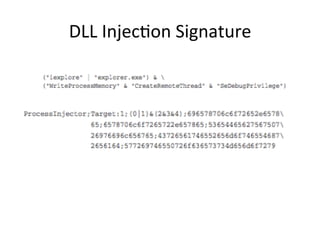Automatic tool for static analysis
- 1. Automa'c Tool for Sta'c Analysis 2014.09.27 C.K.Chen
- 2. Outline • ClamAV • YARA
- 3. Signature-‐based Analysis • Most of current an'virus are based on signatures to detect malware
- 4. ClamAV • ClamAV is an open source an'virus engine – Fast and flexible framework for detec'ng malicious code – Write signatures and scan a broad range of content without wri'ng specific parsers
- 5. Func'onali'es of ClamAV • detec'on databases in ClamAV – MD5 hashes of known malicious binaries (stored in .hdb) – MD5 hashes of PE sec'ons (stored in .mdb) – Hexadecimal signatures (stored in .ndb) – Archive metadata signatures (stored in .zmd or .rmd) – White list database of known good files (stored in .fp) – Matching signatures (stored in .ldb) – Icon signatures (stored in .ldb) – PE metadata strings (stored in .ldb or .ndb) – Container metadata (stored in .cdb)
- 6. Database • ClamAV signatures exist in – /usr/local/share/clamav – /usr/lib/clamav • Database – The main.cld file contains the primary base of signatures – daily.cld contains incremental daily updates
- 7. Signature • SigName:Target:Offset:HexadecimalSignature • SigName field is a unique, descrip've name for your signature • Target – 0 = Any file type – 1 = Windows PE – 2 = OLE (e.g. Office, VBA) – 3 = Normalized HTML – 4 = E-‐mail file (e.g. RFC822 message, TNEF) – 5 = Image files (e.g. jpeg, png) – 6 = ELF – 7 = Normalized ASCII file – 8 = Unused – 9 = Mach-‐O binaries (new in v0.96)
- 8. SigTool • Sigtool – -‐-‐hex-‐dump: convert data from string to hex – -‐-‐md5: generate md5 cheksum in signature format – -‐-‐mdb: generate .mdb signature – -‐u: Unpack a CVD/CLD signature
- 9. XF.Sic.E Signature • daily.ndb:XF.Sic.E:2:*: – 2a2a536574204f75722056616c75657320616e64 2050 – 617468732a2a??00002a2a416464204e657720576f726b626f 6f6b – 2c20496e66642049742c205361766520497420417320426f6f – 312e • Detect a string in a file – **Set Our Values and Paths**???**Add New Workbook, Infd It, Save It As Boo1.
- 10. Wildcards • ?? -‐ Match any byte • * -‐ Match any number of bytes. • {n} – Match n bytes. • {-‐n} – Match n or less bytes. • {n-‐} – Match n or more bytes. • (a|b) – Match a and b (you Can Use More Alternate characters)
- 11. Use Your own database • clamscan –d <your database> target_file
- 12. Prace'ce • Write signature for file containing helloworld – If hello world is in 200~300 byte ?
- 13. Conficker Signature • Unpack database – Sigtool –u main.cvd • Grep for conficker
- 14. Byte Signature • ShellcodeXOR:0:*:33c966b9????80340a?? b2??eb
- 15. Logical Signatures • Recent versions of ClamAV is capable to understand complex signatures based on logical expressions – SigName;Target;Expression;Sig0;Sig1;….;SigN – The field consists of a logical expression where each signature is represented by its index value – Operators OR (|) and AND (&). – =,< ,> , you can control the number of occurrences of each signature that must be found in a file before producing an alert.
- 17. Sec'on Signature • Use sec'on informa'on to construct signature – More robust than all file checksum
- 18. MD5 Signature • sigtool –md5 test.exe > test.hdb • Cat to see signature format
- 19. Type of Database
- 20. Prac'ce • Develop signature for bot.exe – String – MD5 – Hash of Sec'on – Else …..
- 21. Yara • Flexible iden'fica'on and classifica'on engine – rules that detect strings, instruc'on sequences, regular expressions, byte paxerns, and so on – scan files using the command-‐line u'lity – C or Python tools with YARA’s API
- 22. What yara signature looks like? • Clam AV signature • Yara Signature
- 23. The other example • Any file contain $a or $b or $is recognize as silent_banker
- 24. Reserva'on Words
- 25. Condi'on Sec'on • Condi'on block must be exists
- 26. Prac'ce • rule dummy { condi'on: true } • yara my_rule any_file
- 27. String Sec'on • The strings defini'on sec'on can be omixed if the rule doesn’t rely on any string • The strings defini'on sec'on is where the strings that will be part of the rule are defined. • Each string has an iden'fier consis'ng in a $
- 28. Regular expressions • Regular expression is supported
- 29. String offsets or virtual addresse • We are willing to know if the associated string is anywhere within the file or process memory
- 30. Executable entry poin • If file is a Portable Executable (PE) or Executable and Linkable Format (ELF), this variable holds the raw offset of the exectutable’s entry point • If we are scanning a running process entrypoint will hold the virtual address of the main executable’s entry point. • A typical use of this variable is to look for some paxern at the entry point to detect packers or simple file infectors
- 31. VM Detect Rule •
- 32. Compa'ble • ClamAV to yara • Peid to yara
- 33. Prace'ce • Write the rule for bot.exe

































